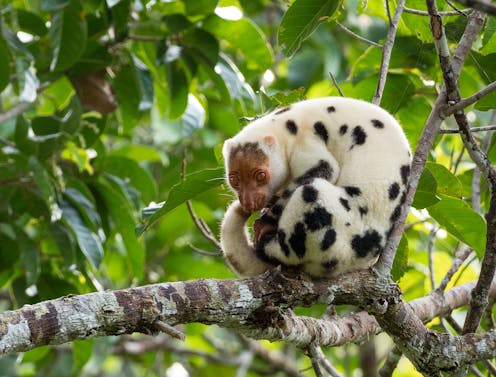Meet 5 marvellous mammals of the South Pacific you've probably never heard of
- Written by Tyrone Lavery, The University of Melbourne

Islands are renowned for their weird and wonderful wildlife. These isolated ecosystems present unparalleled opportunities to study evolution, and the archipelagos of the southwest Pacific are no exception.
This vast and diverse region encompasses 24 nations and territories. It also includes four “biodiversity hotspots[1]”: the East Melanesian Islands, Polynesia-Micronesia, New Caledonia and New Zealand. Each contains at least 1,500 plant species found nowhere else on Earth. So their total land area may be small, but south-west Pacific islands punch well above their weight in terms of their contributions to global biodiversity.
Our latest book[2] provides glimpses of more than 180 native mammals of the southwest Pacific, on islands that fall under the banners of Polynesia, Micronesia and Melanesia (but excluding the island of New Guinea). Indigenous species of marsupials, bats, rodents and a monotreme are among the animals found here. Not surprisingly, half of these are endemic. Many are found only on a single island or small group of islands.
Let’s meet five charismatic species you’ve probably never have heard of, but simply must get to know.
1. Black dorcopsis or black forest wallaby (Dorcopsis atrata)
Conservation status: critically endangered
Distribution: Goodenough Island (Papua New Guinea)
At the southeastern tip of Papua New Guinea is the gravity-defying Goodenough Island. It looms more than 2,500 metres above sea level, but it’s only about 3,900 metres wide – at the widest point.
Goodenough’s higher peaks are covered in rare forests. Here among the clouds is the only place you’ll find black dorcopsis.
Black dorcopsis often have very worn claws, suggesting they spend a great deal of time digging for truffles[3] in the rocky soil. This probably plays an important role in dispersing fungi throughout their habitat.
Curiously, some appear to be wearing white gloves, on one or both front paws. Others do not. No one knows why.
2. Waigeo cuscus (Spilocuscus papuensis)
Conservation status: vulnerable
Distribution: Waigeo (Indonesia)
Waigeo cuscus have a remarkable coat. Irregular black splotches stand out against a background of almost pure white. In young animals these contrasting colours are subdued by the presence of blackish-grey tips to the hairs.
The cuscus have been photographed in the branches of fruiting fig (Ficus spp.) and breadfruit (Artocarpus altilis) trees, so they have a taste for fruit.
3. Bougainville melomys (Melomys bougainville)
Conservation status: data deficient
Distribution: Bougainville (Papua New Guinea), Choiseul and Mono (Solomon Islands)
Pacific Island native rodents have proven vulnerable to disturbance, but thankfully Bougainville melomys seems to remain relatively common.
The contrast between orange fur on the head and back, and crisp white fur on the belly is rather attractive.
An active climber, Bougainville melomys can be found tiptoeing along thin woody vines (lianas), in fruiting trees among Bismarck common cuscuses (Phalanger breviceps), or scaling the trunks of wild betel nut palms (Areca spp.). They’ll tolerate disturbance and have been known to visit village edges to nibble on cultivated bananas.
4. Lesser sheath-tailed bat (Mosia nigrescens)
Conservation status: least concern
Distribution: Widespread throughout Indonesia, Papua New Guinea and Solomon Islands
If you’re quiet and patient while walking through the palm-filled lowland forests of Melanesia, you might be lucky enough to spot one of the region’s smallest and most common echo locating bats.
Lesser sheath-tailed bats are alert little creatures with good eyesight. They rest in small groups huddled together under the cover of a palm leaf where they’re sheltered from the rain. Although watchful, they’ll stay in place if approached with caution, allowing time to view how neatly stacked they are.
Lesser sheath-tailed bats are among the first to emerge of an evening, leaving their palm tree tents while there is still plenty of twilight. They fly in sharp circles in the open spaces above forests and villages. Then as darkness falls, they move away to focus on other areas.
Later in the evening you can find them back in the same roosts, again lined up front to back, taking a breather from their busy schedule of hunting for insects on the wing.
Read more: Pacific Island bats are utterly fascinating, yet under threat and overlooked. Meet 4 species[4]
5. Palau flying-fox (Pteropus pelewensis)
Conservation status: vulnerable
Distribution: Ulithi, Yap (Federated States of Micronesia), Palau
The south-west Pacific supports an incredible diversity of endemic Pteropus flying-foxes. Over-harvesting and international trade for human consumption pushed most of Micronesia’s flying-foxes to the brink of extinction (and in fact did send two species extinct).
Thankfully the introduction of restrictions under the Convention on International Trade in Endangered Species[5] stabilised populations of the Palau fying-fox. However, it remains vulnerable[6] and threatened by habitat loss and climate change.

















